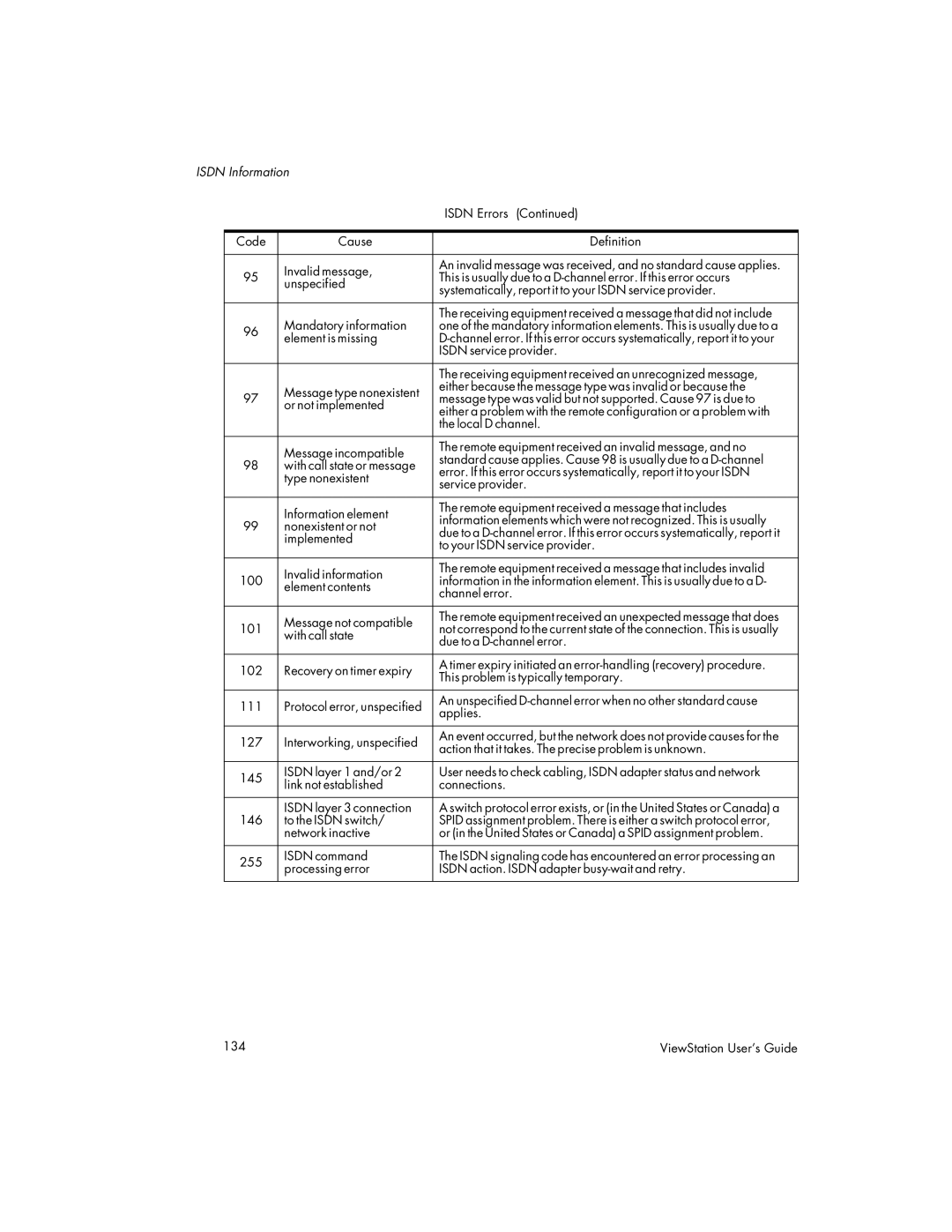ISDN Information
|
| ISDN Errors (Continued) | |
|
|
| |
Code | Cause | Definition | |
|
|
| |
| Invalid message, | An invalid message was received, and no standard cause applies. | |
95 | This is usually due to a | ||
unspecified | |||
| systematically, report it to your ISDN service provider. | ||
|
| ||
|
|
| |
| Mandatory information | The receiving equipment received a message that did not include | |
96 | one of the mandatory information elements. This is usually due to a | ||
element is missing | |||
| |||
|
| ISDN service provider. | |
|
|
| |
|
| The receiving equipment received an unrecognized message, | |
97 | Message type nonexistent | either because the message type was invalid or because the | |
message type was valid but not supported. Cause 97 is due to | |||
or not implemented | |||
| either a problem with the remote configuration or a problem with | ||
|
| ||
|
| the local D channel. | |
|
|
| |
| Message incompatible | The remote equipment received an invalid message, and no | |
| standard cause applies. Cause 98 is usually due to a | ||
98 | with call state or message | ||
error. If this error occurs systematically, report it to your ISDN | |||
| type nonexistent | ||
| service provider. | ||
|
| ||
|
|
| |
| Information element | The remote equipment received a message that includes | |
| information elements which were not recognized. This is usually | ||
99 | nonexistent or not | ||
due to a | |||
| implemented | ||
| to your ISDN service provider. | ||
|
| ||
|
|
| |
| Invalid information | The remote equipment received a message that includes invalid | |
100 | information in the information element. This is usually due to a D- | ||
element contents | |||
| channel error. | ||
|
| ||
|
|
| |
| Message not compatible | The remote equipment received an unexpected message that does | |
101 | not correspond to the current state of the connection. This is usually | ||
with call state | |||
| due to a | ||
|
| ||
|
|
| |
102 | Recovery on timer expiry | A timer expiry initiated an | |
This problem is typically temporary. | |||
|
| ||
|
|
| |
111 | Protocol error, unspecified | An unspecified | |
applies. | |||
|
| ||
|
|
| |
127 | Interworking, unspecified | An event occurred, but the network does not provide causes for the | |
action that it takes. The precise problem is unknown. | |||
|
| ||
|
|
| |
145 | ISDN layer 1 and/or 2 | User needs to check cabling, ISDN adapter status and network | |
link not established | connections. | ||
| |||
|
|
| |
146 | ISDN layer 3 connection | A switch protocol error exists, or (in the United States or Canada) a | |
to the ISDN switch/ | SPID assignment problem. There is either a switch protocol error, | ||
| network inactive | or (in the United States or Canada) a SPID assignment problem. | |
|
|
| |
255 | ISDN command | The ISDN signaling code has encountered an error processing an | |
processing error | ISDN action. ISDN adapter | ||
| |||
|
|
|
134 | ViewStation User’s Guide |
